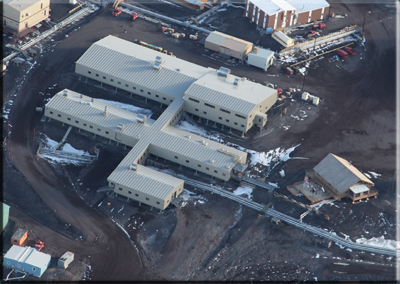The U.S. Antarctic Program includes many organizations that provide logistical and operational support to the field research program. NSF's prime Antarctic logistics contractor is Lockheed-Martin Antarctic Support Contractor (LM ASC) of Centennial, Colorado. LM ASC coordinates research support and field operations in Antarctica and has a planning group that can advise investigators about field or logistical support. Investigators are strongly encouraged to contact the LM ASC Science Planning Group with questions during the proposal preparation phase. (For additional information, contact Jessie Crain, OPP/AIL, (703) 292-7457, email: jlcrain@nsf.gov, or Tim McGovern, OPP/AIL, (703) 292-4248, email: tmcgover@nsf.gov)
Other organizations offer special technical support for research, and your proposal must include a summary document from that organization in the supplemental documents section. More detailed descriptions of the research support provided by the organizations below is available on USAP.gov at http://www.usap.gov/usapgov/proposalInformation/contentHandler.cfm?id=1750.
- UNAVCO (http://facility.unavco.org/project_support/polar/polar.html): High-precision GPS and LIDAR support.
- Alaska Satellite Facility (http://www.asf.alaska.edu/): Synthetic Aperture Radar (SAR) data.
- Ice Drilling Program Office (IDPO) and Ice Drilling Design and Operations Group (IDDO) (http://icedrill.org/): Ice core drilling services. Contact IceDrill@Dartmouth.edu.
- Polar Geospatial Center, the University of Minnesota (http://www.pgc.umn.edu/): Creates, collects, distributes and archives geospatial information about Antarctica.
- PASSCAL Instrument Center provides instrumentation for seismological experiments around the world. PASSCAL support includes seismic instrumentation, equipment maintenance, software, data archiving, training, logistics, and field installation. (http://www.passcal.nmt.edu/content/polar).
The U.S. Antarctic Program supports various automated data collection programs. These include:
- Automated geophysical observatories (AGOs) for unmanned collection of data at remote locations (http://space.augsburg.edu/ago/index.html)
- Automatic weather stations (AWSs) at locations in Antarctica for research and operations. (Maintained by the University of Wisconsin, http://ice.ssec.wisc.edu/).
- Global Monitoring Division of NOAA's Earth System Research Laboratory measures at South Pole Station long-term trends of important trace gases, aerosols, and solar radiation and investigates the influence of theses gases and aerosols on the Earth's climate. The program is supported by USAP (http://www.esrl.noaa.gov/gmd/obop/spo/observatory.html).
- Incorporated Research Institutes for Seismology (IRIS) maintains seismic stations as part of a long-term study of seismicity at Palmer and South Pole stations as part of the IRIS Global Seismographic Network (GSN), a 150+ station global network. (http://www.iris.edu/hq/programs/gsn)
Investigators that require time on an ice-capable research vessel should consult the vessel operating schedules at http://usap.gov/calendarsAndSchedules/ or the relevant program director in Antarctic Sciences to determine availability of ship time. All investigators that request ship time must fill out a UNOLS ship request form.
The U.S. Antarctic Program operates two research ships — the 230-foot Laurence M. Gould and the 308-foot Nathaniel B. Palmer. The capabilities of research ships can be found on Marine Operations home page on the U.S. Antarctic Program web site, USAP.gov.
Underway measurementsInstruments on Nathaniel B. Palmer and Laurence M. Gould are available for not-to-interfere underway measurements on behalf of investigators who do not join a cruise. The "Vessel Science Operations" page (http://www.usap.gov/usapgov/vesselScienceAndOperations/index.cfm?m=3) on U.S. Antarctic Program web portal links to complete lists of available scientific equipment on board the Nathaniel B. Palmer and the Laurence M. Gould.
Both vessels were designed to accommodate biological, oceanographic, geological, and geophysical experiments. Research equipment includes a seismic system, a portable radioisotope laboratory, and dedicated oceanographic instrumentation (e.g., CTD). Both vessels have a deep sea trawl winch and hydrographic winches, cranes, an interior staging area with telescoping side boom, and starboard and aft A-frames. Both vessels also have satellite navigation, radar, and precision depth recorders.
Proposals for management of long-term measurements and data archiving will be considered by the cognizant program director. Technician staffing and other shipboard support should be identified both in the proposal and on the appropriate research ship worksheet.
UNOLS shipsUniversity-National Oceanographic Laboratory Systems (UNOLS) ships operate in the Southern Ocean in some years. Research ships of other Antarctic Treaty nations also operate in Antarctic waters; see "Non-U.S. facilities; international cooperation" in the Antarctic Research solicitation.
- UNOLS (http://www.unols.org/): Ship-board research support. Requests for vessel support must be submitted using the UNOLS Ship Time Request System (https://strs.unols.org/public/diu_login.aspx). When the request is submitted, a PDF file will printed. This can be submitted as part of the supplemental documents in your proposal.
![]()
Proposal Preparation Information for download or printing (PDF file, 296 kB)
![]()
You must have Adobe® Acrobat® Reader® to view PDF files. To obtain a free copy go to the NSF plug-in page (https://www.nsf.gov/help/plugins.jsp) and click the Adobe Reader link.
To request a paper copy contact David Friscic, Office of Polar Programs ,(703) 292-8014, or e-mail dfriscic@nsf.gov for additional information.
 |
The fifth pod is an aquarium room with wet labs and various aquarium tanks designed to hold live animals and to test equipment before it is deployed. |
The Crary Science and Engineering Center, McMurdo Station, has over 4,320 square meters of working space with five sections, called "pods," designed to support research in a different area of the sciences. The main pod contains a library, shared-use computers, conference rooms, administrative offices, shared-use instrument laboratories and equipment/material storage. Three of the pods support research in biology/chemistry, geology and physics/engineering and include laboratory and office space and specialty areas for microscopes, environmental rooms, analytical chemistry labs, staging space, ice and rock sectioning rooms, chemical storage, a darkroom, and an electronics workshop. |
Last updated: 01/28/2015


